Belonging to the family Symphytognathidae, the smallest spiders in the world measure less than 0.5 mm in length. Imagine how tiny that spider bite will be!
These minute creatures represent just a fraction of the diverse world of spiders, which accounts for over 50,000 unique species across 132 families. With ongoing discoveries, this number continues to grow, further expanding our understanding of this fascinating arachnid group.
Spider sizes range dramatically, from the massive Goliath birdeater to the tiny Patu digua, which measures a mere 0.37 mm in body length. Other minuscule spiders include members of the Mysmenidae family, measuring between 0.75 mm to 3 mm in leg span, and certain jumping spiders (Salticinae) which can be as small as 1.4 mm, like the neon spider.
Table of Contents
Symphytognathidae
1. Patu digua
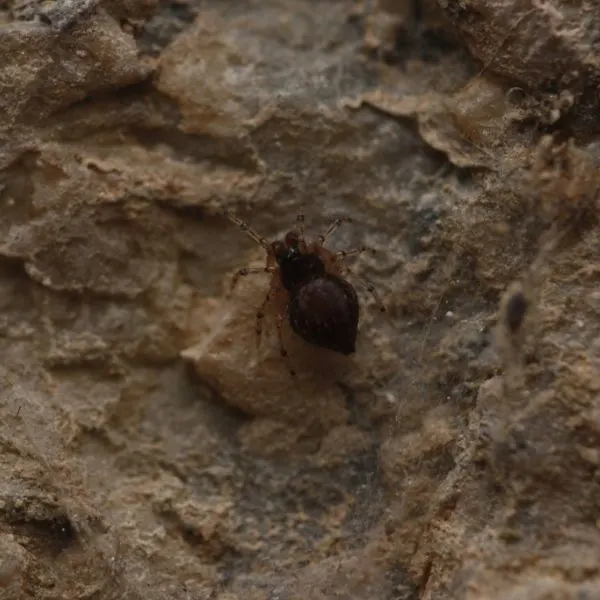
- Family: Symphytognathidae
- Binomial Nomenclature: Patu digua
- Size: 0.37 mm (0.015 in)
- Geographic Range: Río Digua, Columbia
The smallest spider on record is Patu digua. Of course, in the future, it is possible that an even smaller spider will be discovered.
The smallest Patu digua on record are male specimens in Río Digua, Columbia. These males have an adult body length of 0.37 mm. This is smaller than the head of a pin.
2. Anapistula ataecina
- Family: Symphytognathidae
- Binomial Nomenclature: Anapistula ataecina
- Size: 0.43 mm (0.017 inches)
- Geographic Range: Frade cave system, Portugal
Anapistula ataecina are the smallest female spiders in the world. The smallest female spider on record was found in the Frade cave system in Portugal.
Perhaps, the males of these species are even smaller. Unfortunately, males are yet to be discovered. This tiny female has an adult body length of 0.43 mm or 0.018 inches. Anapistula ataecina is small enough to fit on the head of a pin.
3. Samoan Moss Spider
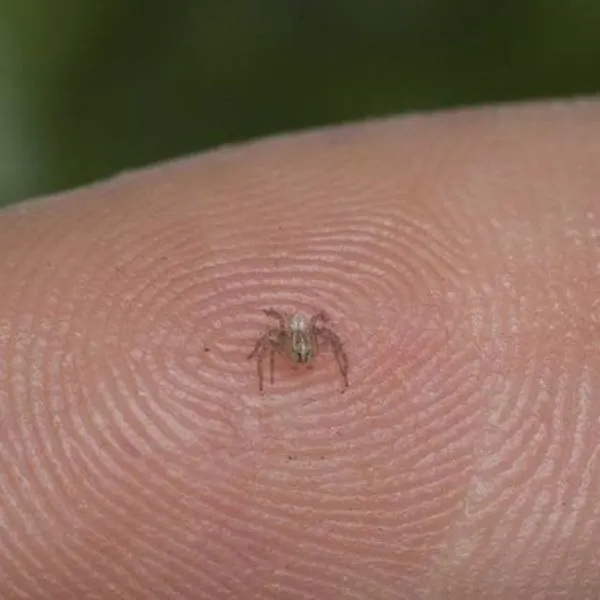
- Family: Symphytognathidae
- Binomial Nomenclature: Patu marplesi
- Size: 0.46 mm (0.018 in)
- Geographic Range: Samoa
This is one of the smallest spiders in the world. It may even be considered the smallest spider in the world as males reach a length of just 0.46 mm.
The Samoan moss spider inhabits humid areas such as moss and is endemic to Samoa.
Family Mysmenidae
Size: 0.76 to 3 mm (0.03 to 0.12 in)
These spiders are orb-weaving spiders. They are tiny and little is known about them. These spiders inhabit humid environments such as caves and in leaf litter. They are among the smallest spiders in the world.
4. Mysmena wawuensis

- Family: Mysmenidae
- Binomial Nomenclature: Mysmena wawuensis
- Size: 0.75 mm / 0.03 in
- Geographic Range: Sichuan province in China
This is an orb-weaving spider and one of the smallest spiders in the world. This spider grows to a length of just 0.75 mm.
Mysmena wawuensis derives its specific name from Wawu Mountain National Forest Park. this is where it was first discovered.
Mysmena wawuensis is just 0.03 inches or 0.75 mm in length. This makes it one of the smallest spiders in the world. The opisthosoma of this spider is disproportionately big and spots yellow flecks.
The sternum of the Mysmena wawuensis is black and the cephalothorax is brown with dark outlines. Males have round carapaces and females have pear-shaped carapaces.
5. Trogloneta yuensis

- Family: Mysmenidae
- Binomial Nomenclature: Trogloneta yuensis
- Size: 1.01 mm
- Geographic Range: Chongqing province of China
This is another tiny spider. It is among the smallest spiders in the world. Although it is bigger than Mysmena wawuensis, it is just about 1mm in length.
At this size, it is difficult to spot with the naked eye. Trogloneta yuensis just like Mysmena wawuensis has a disproportionally large spherical posterior body.
Trogloneta yuensis is endemic to the Chongqing province of China. Here it inhabits humid environments such as caves, moss, and moist leaf litter.
Family Salticinae
6. Red Weaver-Ant Mimicking Spider

- Family: Salticidae
- Binomial Nomenclature: Myrmaplata plataleoides
- Size: 10 mm
- Geographic Range: Southeast Asia
This spider looks similar to an ant, specifically the Asian weaver ant (Oecophylla smaragdina). Unlike ants, spiders have 8 limbs instead of 6.
The frontmost limbs of the red weaver-ant mimicking jumper resemble feelers and the other six limbs resemble that of an ant. However, upon closer inspection, you will notice that this spider is only pretending to be an ant.
The red weaver-ant mimicking jumper also does not have large compound eyes as ants do. To mimic this, the mimicking jumper has two black patches on the head.
The red weaver-ant mimicking jumper is a tiny spider that reaches a length of just 10 mm.
7. Ballus chalybeius

- Family: Salticidae
- Nomenclature: Ballus chalybeius
- Size: 3 to 4 mm (0.12 to 0.16 inches)
- Geographic Range: Central Europe
This tiny arachnid is a jumping spider of the genus Bacillus. There are several other spiders of this same genus.
Ballus chalybeius is about 3 to 4 millimeters long. They are not even up to a centimeter in length. The prosoma is dark brown and has light markings on it. The legs are yellowish with black rings.
The males are darker in coloration and their front limbs are thicker and darker as seen in the picture above.
8. Ballus rufipes

- Family: Salticidae
- Nomenclature: Ballus rufipes
- Adult Male Length: 3.55 mm
- Adult Female Length: 2.9 mm
- Geographic Range: Southern Europe and North Africa
This is another tiny spider. With this spider, males are larger than females. While males reach a body length of 3.55, females reach a body length of 2.9 mm.
The dorsal prosoma of males is light brown while the dorsal prosoma of females is dark brown. The prosoma has white hair. The opisthosoma is dark brown.
Ballus rufipes inhabit the ground. This species occurs throughout its geographic range which includes Europe, North Africa, Armenia, and Turkey.
9. Dimorphic Jumping Spider

- Family: Salticidae
- Nomenclature: Maevia Inclemens
- Adult Male Length: 4.75 to 6.5 mm (0.187 to 0.256 in)
- Adult Female Length: 6.5 to 8 mm (0.26 to 0.31 in)
- Geographic Range: eastern and mid-western North America
This is a jumping spider found across eastern North America. The species is common within its geographic range which extends from southeastern Canada to Florida to Texas.
The males are significantly smaller than the females. Males reach a length of 4.75 to 6.5 inches while females reach a length of 6 to 8 mm.
10. Neon

- Family: Salticidae
- Genus: Neon
- Adult Length: 1.4 to 3 mm
Neons are among the smallest spiders on earth. Neons reach a body length of 1.4 to 3 mm. They are brown to black in color and move swiftly.
11. Marpissa mucosa
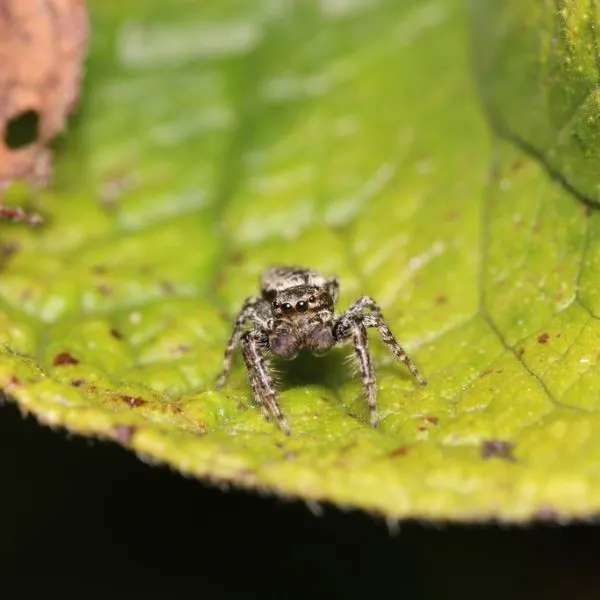
- Family: Salticinae
- Binomial Nomenclature: Marpissa muscosa
- Adult Female Size: 7.5 to 14mm
- Adult Male Size: 6 to 8.1 mm
- Geographic Range: Europe
While this is a small spider, it isn’t as tiny as some of the others on this list. The female Marpissa muscosa reaches an adult body length of 7.5 to 14 mm. Males reach an adult body length of 6 to 8.1 mm. As you can tell, the males are significantly smaller than the females.
The color of this spider is brown. Marpissa muscosa has a furry appearance as it is covered in gray hair. Their coloration is dark brown to grayish brown.
The species is endemic to Northern Europe. It occurs in England although it is quite rare. In England, it is more commonly found in the east and south.
Marpissa muscosa inhabit pine trees and spruce where it lives under the back. It also lives in buildings within its geographic range.
Family Sicariidae
12. Brown Recluse
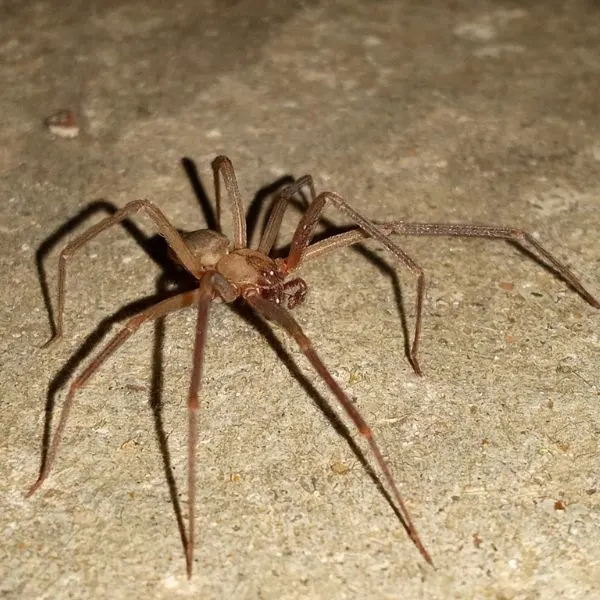
- Family: Sicariidae
- Binomial Nomenclature: Loxosceles reclusa
- Size: 6 to 20 mm (0.24 to 0.79 in)
- Geographic Range: South Eastern North America
This is a recluse spider. It is tiny growing to a length of 6 to 10 mm. It may grow bitter than this. The color of the brown recluse is brown to light brown. Other colorations include blackish gray, dark brown, and even white.
The brown recluse has a violin-shaped dorsal stripe on its cephalothorax.
The species occur in the southeastern United States from eastern Texas o southern Illinois and Georgia.
Araneidae
13. European Garden Spider
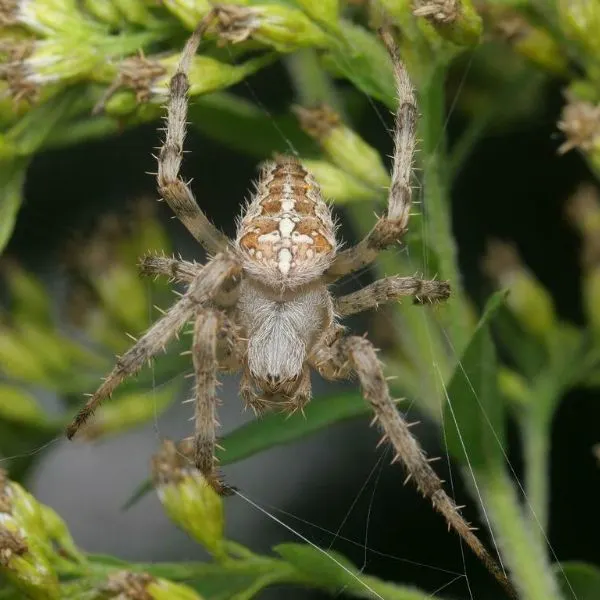
- Family: Araneidae
- Nomenclature: Araneus diadematus
- Adult Male Length: 4 to 11 mm
- Adult Female Length: 10 to 22.5 mm
- Geographic Range: Europe
This spider is endemic to much of Europe and is found in buildings, forest edges, bushes, herbs, and in gardens. It is endemic to most of Europe. Its range outside Europe includes Central Asia and the Far East – China and Japan, Russia, the Middle East, Caucasus, and Turkey. The species has also been introduced to North America where it is found from Canada to Mexico.
The body color of the spider varies from one individual to another. Coloration ranges from black, red, and light yellow to brown.
Frequently Asked Questions
What is the smallest female spider in the world?
The smallest female spider in the world is Anapistula ataecina. The species is endemic to the Frade cave system in Portugal. Anapistula ataecina reaches a length of about 0.43 mm or 0.018 inches. No male specimens have been discovered yet.
What is the smallest male spider in the world?
The smallest male spider is also the smallest spider in the world. This is Patu digua. This extremely tiny spider reaches a body length of just 0.37 mm or 0.015 inches. These arachnids are endemic to Rio Digua in Columbia. This location lends its name to the spider.
What is the smallest spider in the world?
The smallest spider in the world is Patu digua. This tiny spider measures 0.37 mm or 0.015 inches. This record is even acknowledged by the Guinness World Record.
What is the smallest jumping spider?
The smallest jumping spider is the neon. The neon reaches a body length of 1.4 to 3 mm. It is brown to black in color.
How many spiders are there in the world?
There are countless individual spiders according to some estimates there are quadrillions of individual spiders on earth. So far 50,356 spider species have been identified.
Conclusion
The smallest spiders in the world are the spiders that are in the family Symphytognathidae. Symphytognathids such as Patu digua measure just 0.37 mm. Apart from symphytognathids, species of the family Mysmenidae are also extremely tiny. These can be as tiny as 0.75 mm.
Moving on from extremely tiny spiders, there are jumping spiders (Salticinae). These can be extremely tiny, an example is the genus Neon (which can be as small as 1.4 mm). Apart from neons, most jumping spiders are about 3 to 10 mm in size.
Sicariidae and Araneidae also include small spiders with body lengths generally above 4 mm.
Because of their tiny sizes, most of these spiders go unnoticed.
